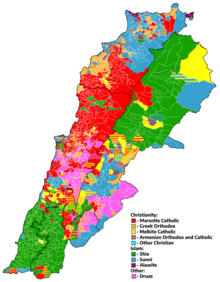The National Pact is an unwritten agreement that laid the foundation of Lebanon as a multiconfessional state following negotiations between the Shia, Sunni, and Maronite leaderships. Erected in the summer of 1943, the National Pact was formed by the then-president Bechara El Khoury and the prime minister Riad Al Solh. Mainly centered around the interests of political elites, the Maronite elite served as a voice for the Christian population of Lebanon while the Sunni elite represented the voice of the Muslim population. The pact also established Lebanon's independence from France.

The Lebanese people are the people inhabiting or originating from Lebanon. The term may also include those who had inhabited Mount Lebanon and the Anti-Lebanon Mountains prior to the creation of the modern Lebanese state. The major religious groups among the Lebanese people within Lebanon are Shia Muslims (27%), Sunni Muslims (27%), Maronite Christians (21%), Greek Orthodox Christians (8%), Melkite Christians (5%), Druze (5%), Protestant Christians (1%). The largest contingent of Lebanese, however, comprise a diaspora in North America, South America, Europe, Australia and Africa, which is predominantly Maronite Christian.

The Catholic Church in Lebanon is part of the worldwide Catholic Church under the spiritual leadership of the Pope in Rome.

Christianity in Lebanon has a long and continuous history. Biblical Scriptures show that Peter and Paul evangelized the Phoenicians, whom they affiliated to the ancient Patriarchate of Antioch. Christianity spread slowly in Lebanon due to pagans who resisted conversion, but it ultimately spread throughout the country. Even after centuries of Muslim rule, it remains the dominant faith of the Mount Lebanon region and has substantial communities elsewhere.

Several different denominations and sects of Islam are practised within Syria, whom collectively, constitute approximately 87% of the population and form a majority in most of the districts of the country.
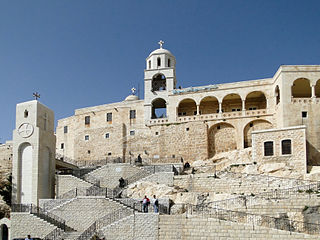
Christians in Syria made up about 10% of the pre-war Syrian population. The country's largest Christian denomination is the Greek Orthodox Church of Antioch, closely followed by the Maronite Church and the Assyrian Church of the East; the cities of Damascus and Aleppo are believed to have the largest number of Christians in Syria. There is a small minority of Protestants in the country.

Keserwan District is a district (qadaa) in Keserwan-Jbeil Governorate, Lebanon, to the northeast of Lebanon's capital Beirut. The capital, Jounieh, is overwhelmingly Maronite Christian. The area is home to the Jabal Moussa Biosphere Reserve.

Arabs represent the major ethnicity in Syria, in addition to the presence of several, much smaller ethnic groups.
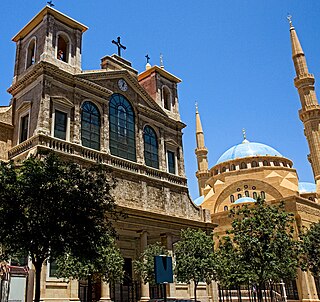
Lebanon is an eastern Mediterranean country that has the most religiously diverse society within the Middle East, comprising 18 recognized religious sects. The religions are Islam and Christianity. The Druze comprise around 5% of Lebanon's population.
For approximately a millennium, the Abrahamic religions have been predominant throughout all of the Middle East. The Abrahamic tradition itself and the three best-known Abrahamic religions originate from the Middle East: Judaism and Christianity emerged in the Levant in the 6th century BCE and the 1st century CE, respectively, while Islam emerged in Arabia in the 7th century CE.

Christianity, which originated in the Middle East during the 1st century AD, is a significant minority religion within the region, characterized by the diversity of its beliefs and traditions, compared to Christianity in other parts of the Old World. Christians now make up approximately 5% of the Middle Eastern population, down from 13% in the early 20th century. Cyprus is the only Christian majority country in the Middle East, with Christians forming between 76% and 78% of the country's total population, most of them adhering to Eastern Orthodox Christianity. Lebanon has the second highest proportion of Christians in the Middle East, around 40%, predominantly Maronites. Egypt has the next largest proportion of Christians, at around 10% of its total population. Copts, numbering around 10 million, constitute the single largest Christian community in the Middle East.
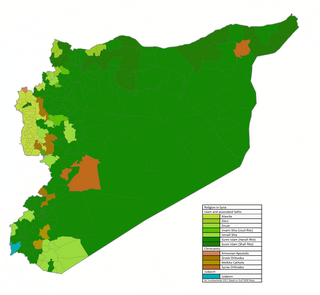
Religion in Syria refers to the range of religions practiced by the citizens of Syria. Historically, the region has been a mosaic of diverse faiths with a range of different sects within each of these religious communities.
According to Article 9 of the Lebanese Constitution, all religions and creeds are to be protected and the exercise of freedom of religion is to be guaranteed providing that the public order is not disturbed. The Constitution declares equality of rights and duties for all citizens without discrimination or preference. Nevertheless, power is distributed among different religious and sectarian groups. The position of president is reserved for a Maronite Christian; the role of Presidency of Parliament for a Shiite Muslim; and the role of Prime Minister for a Sunni Muslim. The government has generally respected these rights; however, the National Pact agreement in 1943 restricted the constitutional provision for apportioning political offices according to religious affiliation. There have been periodic reports of tension between religious groups, attributable to competition for political power, and citizens continue to struggle with the legacy of the civil war that was fought along sectarian lines. Despite sectarian tensions caused by the competition for political power, the Lebanese continue to coexist.

Maronites are a Syriac Christian ethnoreligious group native to the Eastern Mediterranean and Levant region of West Asia, whose members traditionally belong to the Maronite Church, with the largest concentration long residing near Mount Lebanon in modern Lebanon. The Maronite Church is an Eastern Catholic sui iuris particular church in full communion with the pope and the rest of the Catholic Church.
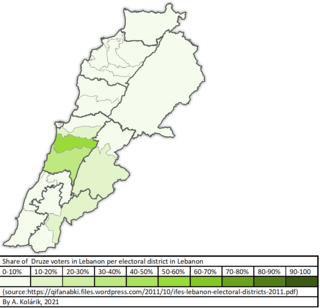
The Lebanese Druze are an ethnoreligious group constituting about 5.2 percent of the population of Lebanon. They follow the Druze faith, which is an esoteric Abrahamic religion originating from the Near East, and self identify as unitarians.
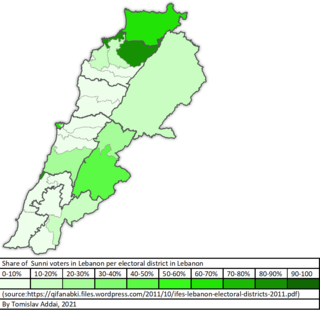
Lebanese Sunni Muslims refers to Lebanese people who are adherents of the Sunni branch of Islam in Lebanon, which is one of the largest denomination in Lebanon tied with Shias. Sunni Islam in Lebanon has a history of more than a millennium. According to a CIA 2018 study, Lebanese Sunni Muslims constitute an estimated 30.6% of Lebanon's population.
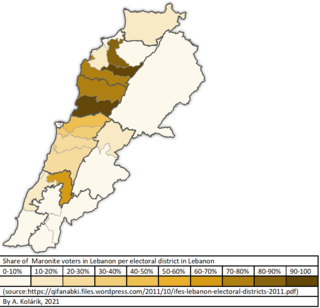
Lebanese Maronite Christians refers to Lebanese people who are members of the Maronite Church in Lebanon, the largest Christian denomination in the country. The Lebanese Maronite population is concentrated mainly in Mount Lebanon and East Beirut. They are believed to constitute about 30% of the total population of Lebanon.
Lebanese Protestant Christians refers to Lebanese people who are adherents of Protestantism in Lebanon.

Beirut I is an electoral district in Lebanon. The district elects eight members of the Lebanese National Assembly – three Armenian Orthodox, one Armenian Catholic, one Greek Catholic, one Greek Orthodox, one Maronite and one Minorities.
Sectarianism in Lebanon refers to the formal and informal organization of Lebanese politics and society along religious lines. It has been formalized and legalized within state and non-state institutions and is inscribed in its constitution. Lebanon recognizes 18 different sects: 67.6% of the population is Muslim, 32.4% is Christian, the majority being Maronites Catholics and Greek Orthodox, while 4.52% is Druze. The foundations of sectarianism in Lebanon date back to the mid-19th century during Ottoman rule. It was subsequently reinforced with the creation of the Republic of Lebanon in 1920 and its 1926 constitution, and in the National Pact of 1943. In 1990, with the Taif Agreement, the constitution was revised but did not structurally change aspects relating to political sectarianism. The dynamic nature of sectarianism in Lebanon has prompted some historians and authors to refer to it as "the sectarian state par excellence" because it is a mixture of religious communities and their myriad sub-divisions, with a constitutional and political order to match.






